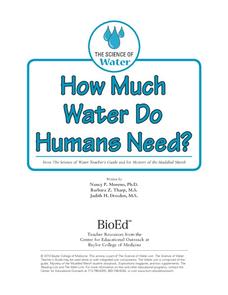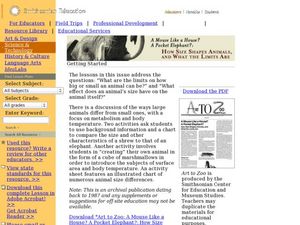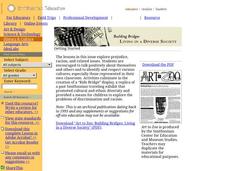Curated OER
Graphing Conversation Hearts
Students collect data and create a graph. In this mathematics lesson, students separate paper hearts by color and create a graph showing the number of hearts of each color present. Students receive a handful of candy hearts that...
Curated OER
Symmetry in Butterflies
Students design butterflies. In this symmetry lesson plan, students examine butterfly pictures, discuss the symmetry of their wings, and create their own symmetry patterns.
Curated OER
Measuring Using Leaves
Students explore geometry by using non-standard measuring methods. In this length estimation lesson, students complete a worksheet in which different objects in their classroom are measured by three different sized leaves. Students draw...
Curated OER
It's Fun to Learn!
Students use the macro mode of the OLYMPUS FE-140 CAMERAS as virtual microscopes to explore different habitats, observe plants, soil, and insects and other creatures. They download those images on electronic files and build web pages....
Baylor College
Do Plants Need Light?
Turn your classroom into a greenhouse with a lesson on plant growth. First, investigate the different parts of seeds, identifying the seed coat, cotyledon, and embryo. Then plant the seeds and watch them grow! Measure the new plants...
Baylor College
How Much Water Do Humans Need?
Physical or life science learners measure the amounts of water eliminated by intestines and the urinary system, and the amounts lost via respiration and perspiration. In doing so, they discover that the body's water must be replenished...
Baylor College
Plant Parts You Eat
Plants provide a variety of delicious foods essential for human survival. In the fourth activity of this series on food science, young scientists investigate common fruits, vegetables, and grains in order to determine which plant part is...
Baylor College
Bio Build-up
Trace pollutants through the environment in the seventh lesson of this series on the science of food. Looking at a picture of the plants and animals in an aquatic ecosystem, learners use dot stickers to represent harmful chemicals as...
Baylor College
What's That Food?
Get things cooking with the first lesson in this series on the science of food. Working in small groups, young scientists make and record observations about different mystery foods. These descriptions are then shared with the class and...
Baylor College
Healthy Snacks
Assess your pupils' ability to identify healthy food choices in the final lesson of this series on food science. Given five different food labels, young nutritionists will rank them from most to least healthy, supporting their choices...
Curated OER
All About Me: My Senses
Students describe the basic senses and then use their senses to describe what they learned.
Curated OER
Conversation Heart Bingo
Primary learners play conversation heart bingo in order to write common phrases. They will create a bingo card with common phrases from conversation heart candy. The teacher calls out phrases and the learners cover them with conversation...
Curated OER
Shamrock Spelling
Review spelling skills by learning about the history of shamrocks. Learners use a picture of a shamrock to practice spelling three letter words. One letter goes on each shamrock leaf. It is a way to engage your kinesthetic learners.
Baylor College
Digestion
Digestion is an amazing and complicated process that provides humans with the energy they need to survive. Lesson six in this series on the science of food uses sliced turkey and a meat tenderizer to demonstrate how enzymes help break...
Curated OER
The Westward Movement
Students study the westward movement through examining stamps. In this westward movement lesson plan, students draw conclusions, determine cause and effect relationships and examine the westward movement of the United States by...
Curated OER
How Size Shapes Animals
Students investigate how size affects large and small animals differently. In this animal lesson plan, students determine how size affects different animals by constructing their own animal out of marshmallows. Once students create...
Curated OER
Learning from Letters and Other Mail
Learners explore the history of our mail system. In this postal lesson plan, students evaluate mail as a means of communication, create a mail system in their classroom where they can send and receive mail. Once the learners receive...
Curated OER
Teaching With the Power of Objects
Students define value of an object. For this value lesson plan, students identify reasons for collecting objects, compile a personal inventory of items they find valuable, and then define why those items are valuable to them. In step...
Curated OER
Building Bridges: Living in a Diverse Society
Students participate in various activities that help them build esteem, and explore racism. In this multicultural lesson plan, Students increase their awareness of, and appreciation for, cultural differences and similarities. This...
Curated OER
Playing Historical Detective: Great Grandmother's Dress and Other Clues to the Life and Times of Annie Steel
Learners draw conclusions about an mystery person based on documents and artifacts provided. In this drawing conclusions lesson, students become detectives by reading and analyzing evidence provided. This lesson includes information on...
Curated OER
Slippery, Slippery Ice
Learners investigate how salt affects ice by experimenting in class. In this water properties lesson, students utilize a penny, salt and pans of ice to examine the sliding ability of a penny across a layer of ice. Learners...
Curated OER
Word Family Arrows
Students identify correct word families. In this word families educational game, students practice matching words to the correct word family.
Curated OER
Class Book: My Favorite Valentine
Young scholars create a class book for Valentine's Day. In this holiday lesson, students draw a picture and write a few sentences about their favorite valentine. Young scholars put their pictures together to create a class book.
Curated OER
Compound Word Heart Match
Students participate in a matching word parts activity. In this heart activity, students match two sides of a heart to make a compound word. Students match the word the teacher puts on the board. Students complete a matching...























